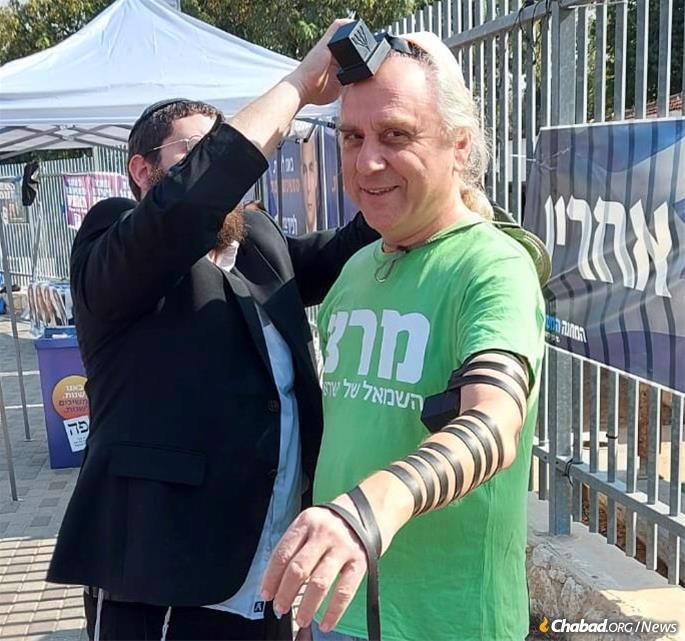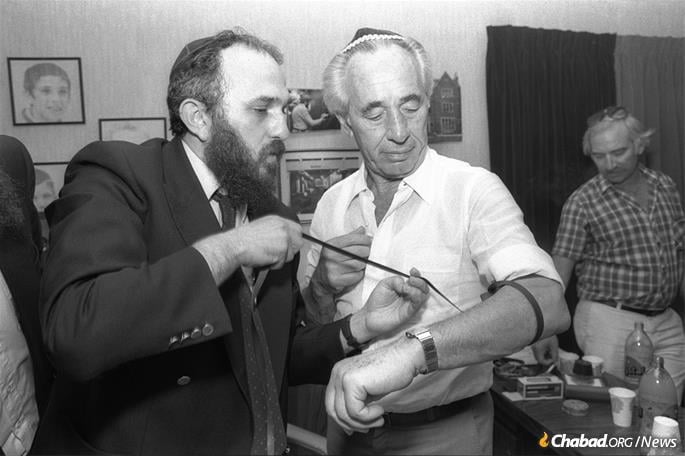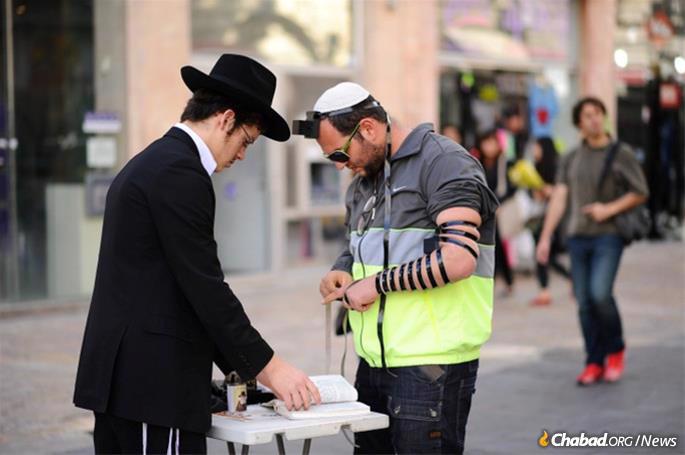
Flood of Support for Chabad After Assault on Tel Aviv Tefillin Stand Goes Viral
by Bruria Efune and Yaakov Ort – chabad.org
In a video taken last week on the streets of Tel Aviv that went viral, an Israeli woman berates a Chabad-Lubavitch rabbinical student for helping Jewish men, including teenagers, put on tefillin and recite the Shema prayer. Instead of reacting angrily to the invective, the volunteer patiently offered her Shabbat candles and explained that he simply cares about every Jew.
In the days since, Chabad in Israel has seen a broad, overwhelming outpouring of support from across Israel’s political and religious spectrum, particularly for the tefillin program. Thousands, some of whom haven’t worn tefillin in years, have been stopping by nearby tefillin stands to perform the mitzvah, even waiting in lines in some locations for the opportunity to do so. Many have also taken to social media to share their positive experiences and sentiments about Chabad in particular.
Tel Avivan Reuven Segal posted on Twitter that the incident will hopefully inspire him to put on tefillin. He wrote, “I haven’t prayed all year, I don’t keep mitzvot and don’t put on tefillin, but now when I come across a Chabad stand, I will try not to refuse to put them on. For me, this is a start.”
Another Twitter user, Amos Yaar, wrote: “I am completely secular and oppose judicial reform, I’m a Meretz voter, and I have no problem with the Chabad stands. Sometimes, I put on tefillin there with my son.”
The hostility directed towards the Chabad volunteer in the viral video clip—who stands in for, as they’re known endearingly throughout Israeli society, Chabadnikim at large—has provoked a massive backlash, as have similar episodes like the ridiculing of a Chabad rabbi in 2018 by an Israeli professor at Ben-Gurion International Airport as he offered his fellow travelers to don tefillin.
“Thank you,” responded David Cameron of Tel Aviv in response to last week’s incident. “You convinced me to put on tefillin today at the entrance to the Carmel market. I hadn’t put them on since my bar mitzvah, but your poisonous post made me stop and hug the Chabad emissary to say ‘thank you’ and put on tefillin. So thank you for spreading Judaism.”
The video comes amid a divisive political battle over judicial reform that some have framed as a conflict between Israel’s religious and secular Jews, with some trying to pull Chabad into the fray of the political and culture war. A few loud individuals have even demanded that Chabad’s popular tefillin stands in municipalities around the country be shuttered, especially those near schools.
Dating Back to 1967 and Six-Day War
Chabad’s role in Israeli society has always been one of unity and Ahavat Yisroel (“love of a fellow Jew”), building deep bonds of mutual admiration with all parts of society. There is longstanding and widespread support for Chabad’s effort to encourage Jewish men of all ages to observe the sacred mitzvah of tefillin that dates back to the Six-Day War in June 1967.
Among the regulars at Chabad’s tefillin stands are supporters of the coalition’s conservative and religious parties, as well as those in opposition, including opposition leader Benny Ganz, who has frequently put on tefillin with Chabad volunteers. When a member of the left-wing Meretz Party made news last year similarly attacking Chabad’s tefillin campaign, Zehava Gal-On—a former leader of Meretz and president of the Zulat Institute for Equality and Human Rights—posted pictures of party members wearing Meretz shirts and donning tefillin at Chabad stands.

The tefillin controversy has also sparked renewed support for Chabad from other traditionally observant communities, including from within the Lithuanian Jewish community. Even after they’d begun emulating Chabad’s engagement with Jews from non-observant backgrounds, for years, segments of the Orthodox Jewish world shied away from Chabad’s tefillin campaign, some even expressing a negative attitude towards the idea. Writing in Cross Currents, an online Orthodox Jewish journal of thought, Rabbi Yitzchock Alderstein acknowledged that “the rest of us were wrong all along. We neglected to see what Chabad was really accomplishing with their tefillin booths. It had little to do with tefillin, and everything to do with conveying a simple but powerful message: We love you as brothers and sisters.”
One of the most public recent showings of support appeared on Israel’s Channel 14, when hundreds of thousands of Israelis watched as Shai Golden donned tefillin on live television with the help of Rabbi Adi Elefant, a Chabad emissary in central Tel Aviv.
Golden said his deliberate demonstration of Jewish pride and support for the work of Chabad came as a direct response to the viral video.
Speaking on his popular morning show, Golden expressed his disappointment in the woman’s attitude and bullying, and praised the response of Shlomo Gerber, the rabbinical student at Yeshiva Chabad Chazon Eliyahu in Tel Aviv who she berated. Golden insisted that her behavior did not represent Israelis.

“The majority of the people in Israel think the opposite of what you think,” Golden said. “Most of the people of Israel love their Torah. Most of the people of Israel love their religion. Most of the men of Israel enjoy, are proud of and love to put on tefillin. And you, and this type of violence, will not win. It will not happen. We will continue to love the Torah, we will continue to love Judaism, we will continue to love Hashem, whether we have a kippah or not. Whether we are religious or secular, continue to love Hashem, continue to love Judaism!”
The History of Tefillin Stands
Tefillin stands are popular sites across Israel and around the world—often simply a portable table with tefillin and instructional pamphlets, as well as Shabbat candles for women, manned by volunteers who assist individuals who may need guidance with wrapping and reciting the blessing. Chabad set up its first tefillin stand in June of 1967 at the newly liberated Western Wall in Jerusalem, where it remains active to this day. Golden, the talk-show host, welcomed Elefant to discuss the origins of the tefillin campaign, and how it brought about a national confidence and hope to an Israeli public grappling with fear of annihilation two short decades after the Holocaust.
“In 1967, ahead of the Six-Day War, the Rebbe [Rabbi Menachem M. Schneerson, of righteous memory] asked that we go to the battlefields and the war fronts, and help the Jewish soldiers and civilians to put on tefillin,” Elefant explained. “The Rebbe expressed that when a Jew puts on tefillin, it causes the enemies of the Jewish people to be afraid. And indeed, it was a miraculous victory for the Jewish people.”

Today, almost all Israelis are very happy to put on tefillin when approached, Elefant told the audience. “They smile and are eager to connect with their heritage and do a mitzvah,” the rabbi said. “The unkind remarks have actually inspired many more people than usual to come to tefillin stands and ask to put on tefillin.”
Another person inspired by the controversy is Knesset Speaker Amir Ohana. At a special event in the Knesset on Monday held in honor of the Rebbe, Ohana declared that he makes sure to stop at any tefillin stand he sees and makes sure to do the mitzvah. “Don’t stop, don’t slow down—continue to put tefillin on every Jew,” he urged his fellow parliamentarians. “After this speech, I will go to the Knesset tefillin stand and put on tefillin!”
In the Tel Aviv studio, before standing up to put on tefillin with Elefant, Shai Golden reiterated: “Know that we at Channel 14, me in particular, and many others, are proud—proud! To make a Kiddush Hashem! To don tefillin live on the broadcast, proud to invite the rabbi and to talk about this important action and mitzvah! We are proud!”
While wrapping the straps around Golden’s arms, Elefant explained that donning tefillin daily is like a Wi-Fi connection to Above, which refreshes the mind and heart for a new day.
After his appearance on Channel 14, Elefant told Chabad.org that he was simply elated to have helped to spread a positive message, saying: “I’m happy that this inspired thousands to put tefillin on themselves and others, and to be happy, proud Jews.”













